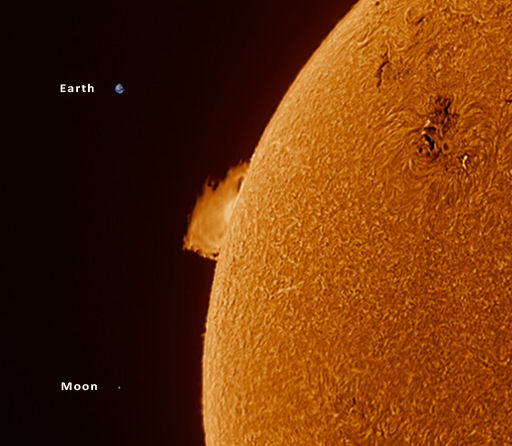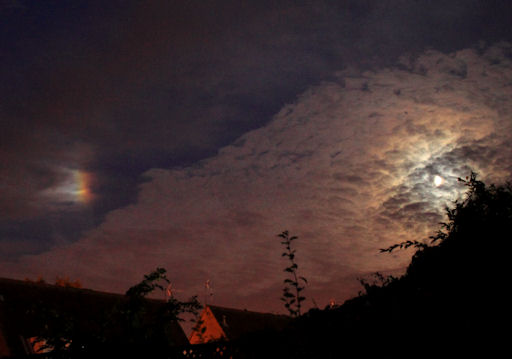Metallic photos of the sun by renowned photographer Greg Piepol bring together the best of art and science. Buy one or a whole set. They make a stellar gift. | | |
QUIET SUN: Except for some minor rumblings on the sun's northeastern limb, solar activity is very low. The sun's X-ray output has nearly flatlined and NOAA forcasters put the odds of a major flare today at less than 10%.
THE SCALE OF THINGS: For the past few days, amateur astronomers have been monitoring a big cloud of plasma hovering above the sun's eastern horizon. How big is it? Göran Strand of Frösön, Sweden, superposed the Earth and moon on a picture he took yesterday to show the scale of things:

"It was an amazing view through my binoviewer," says Strand. "I placed the Earth and moon at their correct separation: 384,400 km apart. This is one big prominence."
The cloud is held aloft by solar magnetic fields. If those fields become unstable then the cloud could collapse, hitting the stellar surface and producing a Hyder flare. Amateur astronomers with backyard solar telescopes are encouraged to monitor developments.
Realtime Space Weather Photo Gallery
WATCH OUT FOR MOONDOGS: The moon is waxing full this week, which means it's a great time to look out for moondogs. They appear 23 degrees from the moon, splashes of light shining with the colors of a rainbow, but they are not rainbows. Barry Starling of Histon UK photgraphed this specimen on August 25th:

Unlike rainbows, which are caused by raindrops, moondogs are caused by ice crystals. Even during the summer, high clouds are cold enough for water in them to crystallize. When moonlight shines through the icy clouds, voila!--a moondog. High-altitude ice crystals can also make moon haloes and pillars, so watch out for them, too.
Realtime Aurora Photo Gallery
Realtime Noctilucent Cloud Photo Gallery
[previous years: 2003, 2004, 2005, 2006, 2007, 2008, 2009, 2011]
Potentially Hazardous Asteroids (
PHAs) are space rocks larger than approximately 100m that can come closer to Earth than 0.05 AU. None of the known PHAs is on a collision course with our planet, although astronomers are finding
new ones all the time.
On August 28, 2012 there were potentially hazardous asteroids.
Notes: LD means "Lunar Distance." 1 LD = 384,401 km, the distance between Earth and the Moon. 1 LD also equals 0.00256 AU. MAG is the visual magnitude of the asteroid on the date of closest approach. | | The official U.S. government space weather bureau |
| | The first place to look for information about sundogs, pillars, rainbows and related phenomena. |
| | Researchers call it a "Hubble for the sun." SDO is the most advanced solar observatory ever. |
| | 3D views of the sun from NASA's Solar and Terrestrial Relations Observatory |
| | Realtime and archival images of the Sun from SOHO. |
| | from the NOAA Space Environment Center |
| | the underlying science of space weather |

